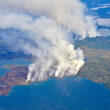In the complex web of Earth’s meteorological phenomena, one natural marvel stands out – the Atmospheric River. Often referred to as “rivers in the sky,” these atmospheric corridors play a pivotal role in the global water cycle, impacting weather patterns, climate, and even the occurrence of extreme events. In this article, we will embark on a journey to unravel the mysteries of atmospheric rivers, exploring their significance, formation, and the profound influence they wield on our planet.
What Is an Atmospheric River?
Atmospheric rivers are elongated, narrow bands of concentrated moisture in the Earth’s atmosphere. These moisture-laden air masses extend thousands of kilometers across the sky, transporting vast quantities of water vapor from one location to another. They are responsible for a substantial portion of the world’s rainfall and snowfall, making them a critical component of Earth’s hydrological cycle.
The Anatomy of an Atmospheric River
To comprehend atmospheric rivers better, let’s break down their essential components:
1. Origin
Atmospheric rivers typically originate in tropical and subtropical regions, where warm ocean water evaporates and saturates the air with moisture.
2. Transportation
These moisture-laden air masses are then propelled by prevailing winds towards higher latitudes and landmasses.
3. Impact
Upon reaching coastal areas or mountain ranges, atmospheric rivers release their moisture in the form of heavy rainfall or snowfall.
Types of Atmospheric Rivers
There are two primary types of atmospheric rivers:
1. Warm Moisture Transport
These atmospheric rivers bring warm, moist air from tropical regions, often resulting in heavy rainfall and flooding.
2. Cold Moisture Transport
Cold moisture transport atmospheric rivers, on the other hand, are responsible for delivering snowfall in regions with colder temperatures.
The Role of Atmospheric Rivers in Weather and Climate
Atmospheric rivers have a profound influence on various aspects of Earth’s climate and weather patterns:
1. Drought Alleviation
In regions suffering from drought, the arrival of an atmospheric river can bring much-needed relief through substantial precipitation.
2. Flooding
Conversely, when these rivers in the sky encounter topographical barriers, they can lead to excessive rainfall, causing floods.
3. Snowpack Formation
In mountainous areas, atmospheric rivers contribute significantly to the accumulation of snow, which serves as a crucial water source during the dry season.
The Impact of Climate Change
Climate change is altering the dynamics of atmospheric rivers. With rising global temperatures, these phenomena are becoming more intense and unpredictable. Understanding this impact is essential for adapting to the changing climate.
Conclusion
Atmospheric rivers are captivating meteorological wonders that play a vital role in shaping our planet’s weather and climate. They are both a source of life-giving water and a potential threat when their intensity is unchecked. As we continue to study and monitor these natural water highways, we gain valuable insights into the intricate mechanisms that govern our world’s climate.
Similar Articles
- Arctic Amplification: Unraveling the Mysteries of Polar Climate
- Aquaponics: A Sustainable Farming Revolution
FAQs
1. Are atmospheric rivers the same as regular rivers?
No, atmospheric rivers are not the same as rivers on the Earth’s surface. They are concentrated moisture corridors in the atmosphere, whereas regular rivers are bodies of flowing water on the ground.
2. How long do atmospheric rivers typically last?
The duration of atmospheric rivers can vary widely, from a few hours to several days, depending on their size and intensity.
3. Do atmospheric rivers only bring rain?
No, atmospheric rivers can bring both rain and snow, depending on factors such as temperature and terrain.
4. Are atmospheric rivers related to hurricanes?
While atmospheric rivers and hurricanes are distinct meteorological phenomena, they can interact and influence each other’s behavior, especially in coastal regions.
5. How can we prepare for the impact of atmospheric rivers?
Preparation involves monitoring weather forecasts, maintaining infrastructure for flood control, and implementing sustainable land use practices to mitigate the impact of heavy rainfall associated with atmospheric rivers.
In conclusion, atmospheric rivers are awe-inspiring natural occurrences that remind us of the intricate interplay between Earth’s elements. Their significance in replenishing water resources and shaping climate patterns cannot be overstated. As we continue to study and understand these dynamic phenomena, we can better adapt to the changing climate and its potential challenges.










